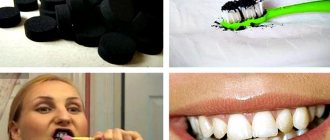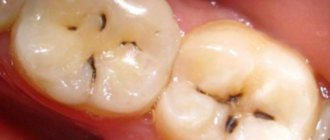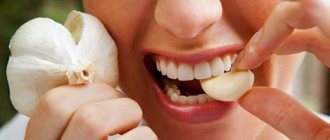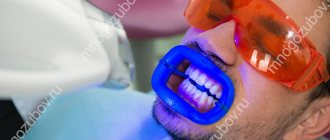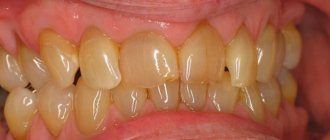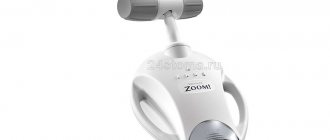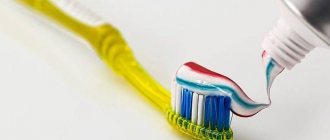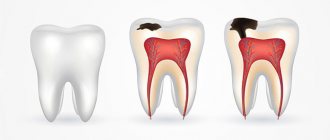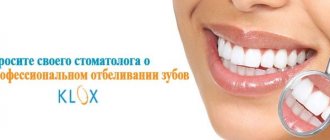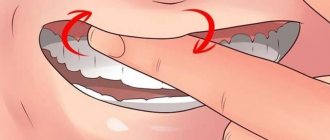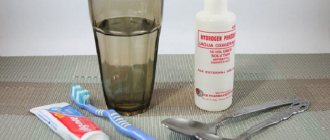There are so many ways that have not been invented to whiten teeth. They rub hydrogen peroxide and vegetable oils into the enamel, brush their teeth with soda or activated carbon, convincing themselves that beauty requires sacrifice. Everyone wants to get results quickly, without much effort and expense. But, as you know, the miser pays twice. Should you trust dubious folk recipes and risk your health? Today we will tell you everything about teeth whitening at home: what you can and cannot do to achieve the desired result.
Who should really whiten their teeth?
The main reason for teeth whitening is darkening or yellowing of tooth enamel, when plaque penetrates into the teeth so deeply that ordinary hygiene procedures do not help get rid of it.
Causes of darkening of enamel:
- Smoking.
Nicotine settles on tooth enamel and penetrates deep into it. Teeth take on an extremely unaesthetic “smoky” appearance. Toothpastes with a whitening effect are too mild to cope with the plaque of tobacco tars and nicotine. Home whitening will restore the natural whiteness of your teeth, but they may darken again due to a negative habit;
- Excessive consumption of sweets.
The interaction of microorganisms living in the mouth with carbohydrates leads to biochemical reactions with the release of various substances. They act aggressively on teeth. The enamel becomes so thin that yellow dentin shows through;
- Drinking coffee and strong tea.
Drinks with dyes negatively affect the color of tooth enamel, which can no longer be called snow-white. The color of enamel is affected by red wine, strong tea, natural and instant coffee. Brown plaque on teeth quickly appears with regular consumption of these drinks;
- Use of the antibiotic tetracycline.
If the expectant mother took tetracycline while expecting her baby, the baby's tooth buds will turn yellow. The same effect occurs if children take tetracycline during tooth formation in early childhood (“tetracycline teeth”);
- Excessive intake of fluorine compounds.
Environmental problems associated with poor-quality water or air, food, can cause the development of fluorosis due to an excess of fluoride in the body. This disease is characterized by pockmarked enamel (“speckled teeth”);
- Underdevelopment of dental tissues.
Hypoplasia appears on the teeth in the form of white or yellow spots. They are symmetrical and the same size. If signs of hypoplasia are noticeable when communicating with a person, the affected areas of the teeth are filled or whitened.
Reasons for changes in enamel color
“Teeth can change color for a number of reasons,” comments dentist Tatyana Deich. “Some we cannot influence, others depend on our daily habits.”
1. Heredity. Some people experience color changes due to genetic disorders. One of them is Gunther's disease, in which the teeth become reddish or brown. The shade can change due to disorders of the development of hard tissues, for example, with Stanton-Capdepont syndrome, when, along with darkening, the teeth are quickly destroyed.
2. Taking medications. It is believed that yellowing of dental tissues can be caused by taking certain medications, such as tetracycline antibiotics. According to Tatyana Deitch, this is only partly true. The yellowing effect does not appear in adulthood. It is possible only during the intrauterine development of the baby, when the expectant mother, unknowingly or guided by an unprofessional doctor’s recommendation, takes drugs that are dangerous to the baby. Pregnant women should be especially careful when choosing medications. Not only drugs of the tetracycline group, but also drugs with a high fluoride content have a negative effect on the health and color of a child’s teeth.
3. Dental manipulations. The color may change when the nerve is removed using coloring pastes or the dentist does not clean the dental canals with sufficient quality.
4. Insufficient oral care. The accumulation of plaque on the surface of the teeth makes them dark. Over time, plaque thickens and turns into tartar, which has a yellow or brown tint. The development of caries gives the tooth surface a gray color.
5. Age. With age, the enamel thins and the dental tissues located underneath become noticeable. Therefore, the color of the teeth also changes - they acquire a beige, yellow tint.
“All people’s enamel is colorless and transparent,” says dentist Tatyana Deich. — The color of teeth is given by dentin, the tissue located under the enamel. Dentin can be beige, yellowish, darker or lighter, but it is extremely rarely naturally white. Because of this, a smile cannot be completely white, “Hollywood,” no matter how carefully you take care of your oral cavity.”
pixabay.com/
What do you need to know when trying to whiten your teeth at home?
Teeth whitening is similar to hair bleaching and affects a person's health. Minimizing the harm caused to the body is the main goal of bleaching.
Before teeth whitening, it is advisable to consult a dentist to assess the quality of tooth enamel. It must be strong enough and have the required thickness. The yellowness that forms on the teeth should not penetrate far into the enamel, in which case the home procedure will not bring results.
Before performing a home cosmetic procedure, dental health is assessed for pathologies: periodontitis, periodontitis, alveolar processes, cement fillings, abnormal eruption of wisdom teeth.
Assessing the condition of the fillings is not an unnecessary precaution. If gaps appear between the filling and the tooth tissue, an aggressive substance will penetrate through them and cause destruction of the tooth from the inside.
After treating the enamel and obtaining the desired effect, it is not advisable to smoke or consume products with coloring pigments. Hygienic brushing of teeth should be carried out with a soft toothbrush, as stiffer bristles can cause discomfort. Whitening toothpaste will help maintain the achieved effect.
The procedure for whitening tooth enamel is repeated after 2-4 months.
Causes of yellowing of tooth enamel
Yellow teeth are not always a bad thing. If they have this color naturally, then no measures need to be taken. Teeth that are naturally yellowish are much stronger than teeth that are snow-white. This quality is inherited. Therefore, if the parents, or at least one of them, have yellowish teeth, then the likelihood of transmitting this trait to their offspring is very high.
It is impossible to whiten naturally yellowish teeth without damaging the enamel. Therefore, you need to think three times whether a snow-white smile is worth dental health.
The main causes of yellowing of tooth enamel:
- Smoking. Smokers develop a soft, pale yellow plaque on their teeth that hardens and darkens over time. Long-term smokers may have a brownish tint to their teeth.
- Drinking large amounts of tea or coffee also contributes to tooth enamel staining. This type of deposit, like cigarette deposits, is fairly easy to clean.
- Long-term use of antibiotics, especially from the tetracycline group, also leads to yellowing of the enamel.
- Food dyes, which modern manufacturers add to most products, can also stain teeth.
- People with a sweet tooth often have a yellowish coating on their teeth.
- Age is also one of the reasons for the loss of whiteness. In older people, the enamel is destroyed over time and the formation of secondary dentin begins, which has a yellowish color.
- Discoloration of one or more teeth may be the result of injury. This usually indicates damage to the pulpal area, which can lead to loss of vitality of the tooth.
- Sometimes the cause of yellow spots on the enamel is wearing braces. Especially if they are made from low-quality materials. In this case, stains appear in the places where the braces come into contact with the enamel.
- Insufficiently thorough oral hygiene can also cause darkening of the enamel. In this case, to restore whiteness, simply remove the plaque.
- Properties of water. In some areas, the water is saturated with minerals that turn tooth enamel yellow.
Who should not whiten their teeth and when?
Before you begin whitening your teeth at home or at the dentist, you need to determine the reason for the change in their shade. Darkening or yellowing of teeth can be external or internal, and only external staining can be corrected using traditional methods. Internal causes of tooth discoloration can be very diverse, ranging from enamel hypoplasia, through which darker dentin tissues are visible, to chronic accumulation of brass, tin, iron and other substances.
In addition, there are a number of contraindications for teeth whitening:
- Pregnant women and people with systemic diseases should not undergo whitening in dental offices. As an alternative, you can use some of the tooth-friendly home whitening products, such as activated charcoal;
- Periodontal diseases are a contraindication to whitening, since the lightening components can aggravate the condition of the tissues, provoke bleeding gums and a number of other pathologies;
- For patients with large carious cavities and untreated diseases of the teeth and gums, whitening is contraindicated;
- People who have a lot of fillings in visible areas are not recommended to whiten their teeth, since the aesthetic value of the result in this case is minimal - the fillings either cannot be whitened or lighten too much. After the whitening procedure, you will have to replace them, which can be difficult if there are a lot of fillings;
- Teeth whitening is contraindicated for children under 16 years of age, since their hard tooth tissues are not fully formed, and the bleaching substance can penetrate through them to the nerves and damage them;
- People who wear braces or have recently had them removed should not whiten their teeth. Braces themselves damage tooth enamel, especially the areas of the teeth to which the clasps are attached. After their removal, the teeth do not lose sensitivity for several weeks; it is necessary to maintain this period until complete recovery.
Contraindications
Even if the patient has figured out what is the most effective and best method of teeth whitening, it is necessary to make sure that there are no restrictions. The procedure is contraindicated in:
- gestation and lactation period;
- the patient’s minor age, primary occlusion;
- individual intolerance to the components of whitening products;
- presence of orthodontic structures;
- oncological processes and undergoing a course of chemotherapy;
- damage to hard and soft tissues due to traumatic or other impacts;
- installed artificial prostheses;
- chronic pathologies of teeth and gums in the acute stage, acute dental diseases.
Each case is considered by the dentist individually. If you whiten your teeth if there are absolute restrictions, this can lead to serious complications.
How to whiten teeth enamel with activated carbon?
Activated carbon is a safe means of teeth whitening at home, minimizing mechanical damage to the enamel. In addition, if accidentally swallowed, activated carbon does not cause harm to the body, which cannot be said about other bleaching agents.
The whitening properties of activated carbon components have been known for a long time - one of the “grandmother’s” recipes for a snow-white smile includes brushing your teeth with wood ash. Wood ash was used as tooth powder or simply chewed, trying to do it so that all surfaces of the tooth were affected. This technique has a scientific basis - wood ash contains potassium hydroxide, a powerful abrasive substance that removes plaque from the chewing surface and prevents the formation of stains on the teeth.
Activated carbon can be made from wood ash, fruit seeds, and coconut shells. Activated carbon tablets can be crushed into powder, the fine particles of which will not injure your teeth. You need to brush your teeth with activated carbon in the same way as with tooth powder, but do not press too hard on the brush so as not to scratch the enamel.
A quick way to whiten teeth without preparing powder is to chew two or three tablets at once, then rinse your mouth with warm water several times. Despite all the beneficial whitening properties of charcoal, immediately after the procedure, the smile may “blacken” due to powder particles stuck in the interdental spaces. They are washed thoroughly, after which you can brush your teeth with regular toothpaste.
The positive effect of this procedure lies not only in the abrasive effect of activated carbon, which removes soft plaque, but also in its absorbent effect. Charcoal absorbs toxins, acid-forming substances that can damage tooth enamel and cause stains on its surface. However, you should not use charcoal powder to clean your teeth too often to avoid damage to the enamel and tooth hypersensitivity.
Whitening with strawberries
Strawberries are one of the natural whitening agents. To whiten your teeth with strawberries, you need to crush the berries and apply them to your teeth like toothpaste, or rub the berries over your teeth, pressing slightly so that the juice appears. You can carry out this procedure once a month for 10 minutes. You need to take a large strawberry and grind it. Then add half a teaspoon of baking soda and apply it to your teeth for 5 minutes. Afterwards, you should brush your teeth thoroughly with a toothbrush.
Or you can simply chew a handful of berries and hold the pulp in your mouth for two minutes, and then brush your teeth. You can resort to this sweet whitening method every day.
Teeth whitening with lemon
Therapeutic procedures for teeth using lemon are chemical methods of enamel whitening. They are less traumatic than abrasive bleaching with soda or activated carbon, since the degree of impact can be controlled by simply reducing or increasing the concentration of lemon juice in the solution. Whereas when brushing your teeth with soda, there is a risk of scratching the enamel even with minimal pressure from the toothbrush.
There are several simple and effective recipes using lemon:
- Thoroughly wipe the front surface of the teeth with the peel of a fresh lemon for 3-5 minutes. Make sure that there are no particles of peel or any other food left in the spaces between the teeth. It is a proven fact that the greatest risk for the development of caries, damage and darkening of tooth enamel is not one-time exposure to acid-forming or coloring substances, but the constant presence of food debris. This creates a breeding ground for pathogenic microorganisms that cause most pathologies of the teeth and oral cavity in general;
- A gentle treatment method that is suitable even for people with sensitive teeth. Before brushing your teeth, add 1-2 drops of lemon juice to the toothpaste and carry out the hygiene procedure as usual. Practice no more than twice a week for one month;
- Lemon pulp is used to lighten teeth whose enamel is insensitive to acids. Apply a fresh slice of lemon to your teeth for a couple of minutes until discomfort occurs, then remove and rinse your mouth with warm water;
- A solution of lemon juice in a glass of water can be used to rinse the mouth, using a course of no more than a month. The ratio of the solution components is 1:1, you can reduce the content of lemon juice in case of painful teeth reaction.
Home whitening methods
Home whitening methods are divided into three groups:
- professional sets consisting of a gel and a mouth guard - standard or made according to individual impressions;
- pharmaceutical products with a small content of bleaching substances;
- folk recipes.
The first two methods are based on the action of hydrogen peroxide and urea, which penetrate dentin and oxidize pigment compounds. Since the enamel itself is transparent, the color of the teeth depends solely on the shade of their hard tissues. Procedures according to folk recipes using lemon, soda, activated carbon and other available products are not bleaching, but cleaning from plaque. As a result, the enamel becomes shiny, reflects light better, and the teeth appear whiter.
Homemade enamel lightening with soda
Baking soda can be used for at-home teeth whitening as an abrasive that helps remove soft plaque from the enamel surface. To do this, dilute soda with water to a homogeneous paste, apply it to a brush and brush your teeth. Or leave the medicinal composition on the teeth for a few minutes, then rinse with warm water.
A combination of peroxide and soda, which are mixed until smooth and used instead of toothpaste, brightens the tone of teeth well. Baking soda-based recipes should not be used to clean and whiten teeth more than once every two weeks to prevent thinning of the enamel. At the same time, it is recommended to use fluoride-containing toothpastes to restore the mineral composition of tooth enamel.
When using baking soda to whiten teeth, you need to take precautions. First, make sure that baking soda does not get on your gums, as rubbing it can damage the tissues and cause them to bleed. Secondly, it should be remembered that when the enamel is thinned, this procedure can be dangerous for the teeth, provoke their increased sensitivity and even contribute to the occurrence of caries.
Traditional teeth whitening: undeniable harm and ephemeral benefits?
The reason for the popularity of articles about home whitening remedies, thanks to which thousands of people voluntarily ruin their teeth, is the most important misconception about the essence of whitening. The fact is that professional methods of teeth whitening (and they are the only ones that are effective and safe) involve not affecting the enamel at all, but the inner layer of dental tissue - dentin. And only professional chemical compounds and special catalysts can depigment dentin in a dental clinic under the supervision of a dentist. Most of the recipes for home teeth whitening, offered by pseudo-specialists on the Internet, do not bring any effect at all, but in 99% of cases they harm the teeth.
How to whiten teeth with hydrogen peroxide?
Hydrogen peroxide is a popular means for teeth whitening, and it is used not only at home, but is also part of whitening gels that are used by dentists to professionally lighten enamel by several tones. Naturally, the concentration in all these products is different. For radical lightening, dentists use 30% hydrogen peroxide. Moreover, after each such procedure, the dentist must remineralize the teeth with a medicinal composition in order to prevent the leaching of hydroxyapatites from the enamel. At home, a 3% peroxide solution is sufficient.
There are many recipes for use. The simplest of them is to apply a moistened cotton swab to the stained surface and leave it for several minutes, after which the mouth should be rinsed with warm water. The rules for using peroxide at home are the same as for professional whitening - avoid contact with gums and other soft tissues and ingestion of the solution. In high concentrations, this drug can be dangerous to the body.
Long-term use of hydrogen peroxide can also increase tooth sensitivity to the point of causing a painful reaction not only to heat and cold, but also to sweet and sour foods. It is not recommended to use it more than once a week; after a month's course of treatment, you need to take a break for two to three months.
How the procedure can turn out - possible complications
The active components of the formulations used penetrate through the enamel into the dentin. This layer consists of mineralized collagen tubes in which the processes of odontoblasts with pain receptors are located.
The active ingredients of the brightening gel oxidize the organic elements of dentin, dehydrate and thereby severely injure the processes of odontoblasts. As a result, the enamel becomes not only snow-white, but also more porous, which means weaker and susceptible to external irritants. In the first days after the procedure, many patients complain of increased sensitivity to temperature changes in food and drinks, an acute reaction to sweet, salty and sour foods.
“About 3 years ago I whitened my teeth with ultraviolet light. The pain appeared on the second visit, and on the third it became almost unbearable. The doctor warned that it was better to postpone the third session as much as possible, but I was sorely short of time. In general, in the evening I was saved by painkillers. Then the pain disappeared and everything was fine until I noticed a crack on my front incisor. That's all your safety! I had to restore half a tooth..."
Kris, from correspondence on the woman.ru forum
In severe cases, when violation of the technique leads to complications, a chemical burn of the pulp occurs and the need to remove the nerve arises. Burns to the mucous membrane can also occur if the concentrated gel gets on the gums. With too frequent sessions or prolonged exposure to the lightening gel, cracks and chips may appear on the enamel.
How to whiten teeth using peroxide and baking soda at home?
Any peroxide-based products should not be used without first testing for an allergic reaction. To do this, apply a little hydrogen peroxide to the crook of your elbow or the delicate skin of your wrist and wait a few hours. Additionally, you can conduct a test on the teeth and oral cavity using a highly diluted peroxide solution.
Only after this can you start whitening using these recipes. At the slightest feeling of burning or pain, the composition should be washed off and rinse your mouth several times with warm water. Peroxide should not be used for mouth ulcers, which often occur in heavy smokers, tongue injury during piercing, and other injuries and wounds of the oral cavity. Untreated caries and periodontal tissue diseases are also contraindications to the use of home whitening products.
The following method works most effectively: hydrogen peroxide in a 3% concentration is mixed with baking soda in equal proportions and the resulting slurry is spread with a cotton swab over the surface of the tooth enamel in places that need to be whitened. Leave the mixture for no longer than a minute, then rinse and rinse your mouth. If the composition begins to foam on the teeth, then do not worry - this is a normal part of the procedure. Swallowing the solution even in minimal quantities is prohibited. You can eat and drink no earlier than 30 minutes after the procedure.
Immediately after whitening, you should brush your teeth with fluoride toothpaste to prevent mineral loss.
Read more: Restoring tooth enamel - 5 modern methods
Read more about office techniques
Professional whitening at the dentist involves applying a concentrated gel based on hydrogen peroxide or carbamide to the surface of the front crowns. Next, the composition is illuminated with a laser beam, ultraviolet or LED lamp. Essentially, it is a catalyst that activates chemical processes aimed at discoloring hard tissues. Similar methods, with the exception of laser, are united by a common term - photobleaching. It also does not include chemical bleaching, which involves applying a brightening composition to the enamel without the use of any catalyst.
In-office whitening methods are the most effective
The components of the gel affect not only enamel, but also dentin, although only 20% of its organic substances1. If you do everything correctly and strictly follow the technique of performing the procedure, there will be no serious harm to healthy teeth. You should always remember to take precautions, since too much exposure to the gel can cause pulp burns and other serious consequences.
Now let’s talk in more detail about which teeth whitening is the safest and most effective.
Ultrasonic and Air-Flow sandblasting
Mechanical cleaning with special tools, ultrasound and sandblasting using Air-Flow technology are all ways to remove plaque and remove solid deposits. These techniques cannot be classified as bleaching, since they allow maximum restoration of the natural color. Under the influence of an ultrasonic scaler, hardened deposits are destroyed, while a powerful air-water jet immediately washes away contaminants, and the abrasive particles in its composition carefully polish the enamel. By the way, Air Flow is widely used, including as an independent method of gentle cleaning, but the best effect can only be achieved by combining these techniques and an integrated approach to professional cleaning. hygiene.
The photo shows the method of brushing teeth with the Air Flow system.
The cost of the procedure ranges around 5 thousand rubles.
Laser whitening
The procedure is performed in the dentist's office. The specialist applies a highly concentrated hydrogen peroxide-based brightening gel to the prepared surface and activates its active components using a laser beam. The doctor treats each tooth separately. The technique is considered the most effective and harmless; it allows you to brighten your smile by 10 shades or more. At the same time, the laser beam provides a targeted effect, which reduces the risk of thermal and chemical burns of the mucous membrane, dentin and pulp.
With the laser method, each tooth is processed separately
The cost of one session is approximately 20 thousand rubles.
Photo whitening – ZOOM and Amazing White
When photobleaching using ultraviolet or LED light, a composition based on hydrogen peroxide is usually used in a concentration of 30-35%. After applying the product to the enamel, it is illuminated with a special lamp - the duration of one session does not exceed half an hour. To achieve the desired effect, a maximum of 3 sessions can be carried out, but preferably with sufficient intervals between each other.
ZOOM technology allows you to brighten your smile by 8-10, and sometimes even 12 tones. At the same time, the lightening gel includes calcium phosphate, which provides additional strengthening of the enamel. The cost of the procedure varies within 25 thousand rubles.
The photo shows teeth whitening using the ZOOM system.
Amazing White is another effective photo-whitening system that helps brighten your smile by 7-10 shades with a guarantee of long-term results. When exposed to an LED lamp, the peroxide molecules break down into oxygen and water. Oxygen molecules make their way through the outer layer to the dentin and contribute to a change in its shade. For one session using Amazing White technology you will have to pay about 15 thousand rubles.
Chemical enamel brightening
This technique also involves applying a special activator gel to the surface of the front crowns, but does not involve the use of any additional catalysts in the form of light or a laser beam. The method is not as effective as those described above, but it is more gentle. Using this technology, you can make your smile 5-7 shades lighter.
The photo shows the method of chemical teeth whitening
The cost of one session is usually 12 thousand rubles.
Intracanal technique – endobleaching
If the crown has darkened from the inside, for example, after removal of the pulp (nerve), severe trauma, or the use of coloring materials for filling, regular in-office bleaching is unlikely to help. In such cases, endobleaching is usually prescribed. The procedure is performed on pulpless teeth. The specialist puts the coloring agent directly inside the crown through the hole, and then closes it with a filling. Read more about in-canal technology in our separate article.
The photo shows the intra-canal teeth whitening procedure
The cost of such restoration is from 1000 rubles per tooth.
Toothpaste for home teeth whitening
Whitening toothpastes are most often made based on hydrogen peroxide, organic acids and components that soften their negative effect on enamel. There is another group of products whose effectiveness is based on the abrasive effect of dicalcium phosphate and silicon oxide.
In the first case, the enamel is lightened due to chemical acids and oxygen radicals, which discolor the pigments. As a result, plaque dissolves, and the substances that gave the enamel a yellow-brown tint become colorless, and the smile acquires the desired whiteness.
Abrasive toothpastes promote mechanical plaque removal, which in most cases also leads to the expected results. However, when using products from this group, there is a high probability of developing hyperesthesia - dental hypersensitivity.
The safest option is considered to be pastes based on the enzyme papain, which gently removes plaque and prevents the formation of new deposits without thinning the enamel. But such pastes do not provide instant lightening, like products with more aggressive chemical components in their composition.
In what cases is the procedure indicated?
A correctly selected technique, provided that the teeth and enamel are healthy, can give a noticeable effect after the first session. With the help of modern technologies, specialists have been able to significantly reduce the potential harm without compromising the effectiveness of modern lightening techniques. First, you will need to remove plaque and hardened deposits to return your smile to its natural milky hue. Next, the doctor will no longer act on the surface layer, but on the dentin, due to the oxidation of which he will give the smile a truly Hollywood whiteness, even if by nature the person’s teeth are slightly yellowish.
Teeth become dull and yellow over time
Over the years, the smile fades and turns slightly yellow, losing its vibrant shine. These processes are facilitated by bacterial plaque and deposits, smoking, as well as constant exposure to coloring pigments, which are contained in some foods and drinks - coffee, strong tea, red wine, etc. The cause of yellowness may be genetics, taking potent drugs, non-carious lesions of the enamel. Modern whitening techniques allow you to achieve impeccable whiteness - up to 8-12 shades on the Vita scale. But in order for everything to go without harm to the teeth, it is better to contact dentistry directly, where the process will take place under the supervision of experienced specialists and only after a thorough diagnosis.
Whitening and strengthening teeth with rinses
Whitening mouth rinses are mild products that do not damage tooth enamel, but help restore its mineral composition.
They may contain aggressive chemical components - for example, active oxygen, which removes plaque, brightens teeth and prevents the formation of tartar. For patients with sensitive teeth and thinned tooth enamel, there are rinses based on plant extracts of cinnamon, tea tree, cloves, and mint. They not only prevent darkening of the surface of the teeth, but also have antibacterial properties, prevent caries and gum disease.
You need to keep the rinse in your mouth for one to three minutes; the volume for a single use is two tablespoons. Recommended for daily use for a month.
Why is oral hygiene necessary?
The importance of oral hygiene lies in the prevention of major dental diseases, as well as maintaining an attractive appearance of a person. By following the rules for conducting events, you can achieve significant results, including:
- formation of strong teeth;
- destruction of pathogenic microflora;
- prevention of the development of caries and periodontal disease;
- prevention of infectious diseases of the oral cavity and gastrointestinal tract;
- snow-white smile;
- fresh breath;
- savings on dental services.
As medical practice has shown, people with weakened immune systems and smokers are especially in dire need of hygienic care.
Using whitening gels at home
Homemade whitening gels are used together with special trays to increase the area of contact of the active ingredients with the enamel and increase the degree of whitening. Aligners are made of flexible plastic or silicone and are placed on the upper or lower jaw, depending on which teeth need whitening.
The gel is supplied with the mouth guard, or it can be applied to the mouth guard yourself. Products from different manufacturers vary in composition. Gels for intensive lightening of tooth enamel contain hydrogen peroxide; mouth guards with this composition can be worn for no longer than half an hour; the procedure is repeated twice a day for a two-week course of treatment.
Gentle gels contain urea or carbamide peroxide in a small concentration; they can be worn without removing them for several hours. Therefore, for night whitening at home, it is better to use these gels. Moreover, wearing a mouthguard at work or in public places can cause inconvenience.
Ready-made mouthguards can be purchased at a pharmacy. However, they may not be effective enough, since the structure of the jaw and the sensitivity of the teeth are different for all people. To enhance the whitening effect, you can contact your dentist, who will make a custom mouthguard and help you choose the optimal concentration of active ingredients in the lightening gel.
Prevention measures
Getting rid of yellow plaque on teeth is possible, but the procedure is unpleasant. Therefore, it is better to prevent the formation of darkening in advance. Prevention measures are quite simple, but not everyone follows them. Experts recommend:
- clean your mouth twice a day;
- choose the right brush. If your teeth and gums are healthy, it is recommended to pay attention to medium hardness; this is the best option. If possible, you should use an electric toothbrush; it removes plaque better than a regular one;
- To maintain white teeth, it is very important to stop smoking and also drink less coffee, tea and red wine;
- You need to consume less foods with dyes, in particular, you should not drink sweet soda;
- Tap water must be filtered before use. Or use purchased purified one.
If stains or plaque appear on the enamel, then you should consult a dentist or try to brush your teeth using traditional methods.
Teeth Whitening Strips
This modern product will allow you to achieve a visible cosmetic effect in a short time. Special strips with a brightening composition applied to them can be purchased at a pharmacy chain or in an online store. Consumers with sensitive teeth can purchase a gentler teeth whitening option.
Using the strips is very simple - you need to apply them to your teeth every day and leave them there for at least half an hour. After a month, the enamel will lighten by about 2-3 tones. The effect of a snow-white smile will last a couple of months, then the tooth enamel will darken again. A side effect of the procedure is a temporary increase in tooth sensitivity.
Whitening strips are high-end products; they are in a different price category and are more convenient to use compared to gels and trays. The strips adhere firmly to the teeth, allowing you to talk during the procedure.
The disadvantage of any whitening strips is that the interdental spaces cannot be lightened in this way.
Ready-made whitening products
Those who do not trust folk remedies should pay attention to ready-made whitening products. Before purchasing, you should read the instructions for the drug, as many of them have contraindications. Most whitening products cannot be used:
- with tooth sensitivity;
- during pregnancy and lactation;
- for gum diseases;
- for caries.
The most popular whitening products:
- ROCS "Oxygen bleaching". Available in the form of a gel for cleaning teeth. It is based on active oxygen. In addition to whitening, the drug inhibits the growth of bacteria, prevents the appearance of bad breath, and prevents diseases and gums. It acts gently; to get a noticeable result, you need to brush your teeth for at least three minutes twice a day. The effect will be visible in a month.
- Global White. This is an intensive system that is approved for use at home. It is possible to lighten the tone by 4-5 tones. Active oxygen is also the main one; in addition, potassium is included in the composition, which helps strengthen the enamel. The package includes a cleaning paste, a whitening gel with a brush, and a product to protect the skin of the lips from the irritating effects of drugs.
- Whitening strips. Crest 3d White Whitestrips. The product is very convenient to use. The strips are glued to the teeth for 40-60 minutes, then removed. The manufacturer indicates that teeth can whiten by 2-3 shades.
- Whitening pencil BLIQ From Vanessa. A pencil that contains hydrogen peroxide. Within a week the result will be noticeable, but the manufacturer advises using the product longer - up to 21 days. Then your teeth can be whitened by 4-5 shades.
Whitening Pencil
| This portable type of whitening gel is applied with a special applicator. After the time specified in the instructions, the composition is removed from the enamel. Consumers are offered pencil models, the active substance of which is removed by saliva, without requiring special manipulations. The concentration of the bleaching agent is insignificant compared to the gel that comes with the trays. Therefore, the pencil is used to maintain the whiteness of teeth in “camping” conditions, to remove stains from tea, coffee, and tobacco plaque. |
What are the types and techniques of teeth whitening in dentistry?
All procedures are performed only by a doctor in a clinic using special equipment. Not all methods allow you to get a snow-white smile in one session. Often the procedures are carried out in several successive stages. Safety is the key point, so first of all, patients tend to try more gentle techniques, gradually moving on to serious manipulations.
Mechanical whitening method
First of all, the procedure is aimed at removing plaque, food particles, and dyes. The dentist uses special instruments that quickly and safely remove deposits. The most popular methods remain ultrasonic cleaning and Air Flow. In the second case, a special sandblasting machine is used, which delivers a solution of water, air and fine abrasives under pressure. As a result, the enamel is polished and becomes 5-7 tones lighter.
Laser whitening
The principle of operation of this method is to simultaneously expose the teeth to a solution based on hydrogen peroxide and a laser beam. The device promotes better penetration of the composition into hard tissues.
How the procedure goes:
- the doctor examines the oral cavity and informs the patient about the presence or absence of contraindications;
- plaque and tartar are removed;
- A gel-like substance is applied to the teeth;
- the laser beam acts on each element of the row for half a minute;
- the patient’s oral cavity is cleaned of plaque particles and other debris;
- fluoridation is performed to protect the enamel from harmful effects.
Why is laser teeth whitening effective?
Tangible advantages of the procedure over other methods:
- absence of pain and other discomfort;
- short period of exposure to the laser device;
- the laser disinfects, which means it is an excellent means of preventing oral diseases;
- enamel is lightened up to 10 tones in just one visit to the dental office;
- almost completely harmless to tissues;
- saturation with mineral components at the final stage helps strengthen the enamel layer and prevent increased sensitivity;
- If you complete several procedures in a course, the surface of the teeth will become perfectly smooth, thereby minimizing the risk of further staining by food.
Flaws
The disadvantages include:
- sick cost (comparable to other methods);
- observation of increased tooth sensitivity;
- If medical recommendations are not followed during the recovery period, the enamel will darken very quickly.
Contraindications for laser whitening
The dentist will refuse the procedure if the patient has:
- deep damage to teeth (caries, cracks, chips, erosion);
- orthodontic structures in the mouth (braces, plates, etc.);
- inflammatory processes in soft tissues;
- exposed root part.
It is also not recommended to carry out the procedure during pregnancy, breastfeeding and when the patient is a minor (except when parents give their written consent).
Photobleaching
This is a method in which a special gel-like composition is applied to the teeth, and then the surfaces are illuminated with an ultraviolet lamp. Currently, this type of whitening is considered one of the most modern and effective.
Technologies
Popular options:
- Zoom. Calcium phosphate is added to the mixture for application to teeth, which helps strengthen the enamel. Experts use a UV lamp.
- Amazing White. Hydrogen peroxide molecules break down into water and oxygen. As a result, not only the enamel, but also the dentin layer is lightened.
- Beyond Polus. A halogen lamp and LED are used. A safe procedure with a gentle effect on teeth and an effect of up to a year.
- Luma Cool. LED light bulbs emit a cool light. The process consists of 3 stages of 8 minutes each. With proper care and compliance with medical recommendations, the result can last up to 2 years.
Indications
This type of teeth whitening technique is indicated for:
- the presence of spots on the tooth surfaces (fluorosis);
- staining the enamel yellowish due to taking certain medications;
- age-related changes in the body;
- preparation for prosthetics and installation of veneers.
Contraindications
In what cases should you not resort to the procedure:
- minor age;
- childbearing and lactation period;
- deep carious lesions;
- allergy to the components of the bleaching composition;
- increased tooth sensitivity due to thinning enamel.
Advantages of the method
The tangible advantages of this method of restoring the whiteness of a smile:
- no pain or other discomfort;
- effectiveness (quick whitening effect that lasts 1-3 years);
- safety compared to most alternative procedures;
- session duration is about 15 minutes;
- lightening by 10-12 tones.
Negative sides
Minuses:
- high price;
- increased sensitivity of enamel immediately after dental procedures;
- lack of a pronounced effect in certain treated areas in the presence of prostheses and filling material;
- further remineralization may be required;
- often hard-to-reach areas remain unclarified;
- high risk of burns and injury to mucous membranes if the technological process is not followed.
Chemical bleaching
Doctors apply highly concentrated preparations that contain hydrogen peroxide or other active ingredients to the teeth. As a result, dentin is whitened, its shade becomes lighter by 5-7 tones or more.
In this case, no devices (laser, UV lamp, etc.) are used. The enamel can be lightened at home, but it is much better if the chemicals are applied by a professional.
Indications for chemical teeth whitening
The procedure is indicated for:
- the presence of bad habits that lead to yellowness of hard tissues;
- changes in the shade of enamel due to eating foods containing bright, aggressive dyes;
- long-term use of drugs with tetracycline and other drugs with a similar effect;
- age-related changes in the patient’s body;
- traumatic impact, which led to the destruction of the enamel layer.
Contraindications to the procedure
This type of bleaching is contraindicated if the patient has:
- serious damage to the enamel;
- dental diseases that are not fully treated;
- increased sensitivity to temperature changes, sour, sweet, etc.;
- intolerance to the components included in the gel used to restore a snow-white smile.
Stages of the procedure
Procedure:
- initial examination by a dentist to identify possible contraindications and obtain permission to whiten teeth;
- isolation of soft tissues using special pads that prevent the gel-like product from getting on the gums and mucous membranes;
- directly applying the drug to the surface of the teeth using a brush specially designed for this purpose;
- thoroughly removing any remaining gel in the mouth.
Positive properties of the chemical method
What are the advantages:
- high efficiency in a short period of time, maximum results are visible after half an hour to an hour;
- the effect lasts up to 5 years (if you follow all the rules and do not skip hygiene procedures);
- comparative harmlessness, since apart from the chemical substance the teeth are not affected by any devices;
- no pain.
Disadvantages of the method
Negative sides:
- increased sensitivity of dental units immediately after the procedure;
- high price;
- increased risk of soft tissue burns if the medicinal composition is dosed incorrectly or is taken in too high a concentration of the active substance;
- good results cannot be achieved in one visit to the dentist;
- selectivity (not all hard-to-reach areas will become snow-white).
Endobleaching (intracanal method)
The aesthetic appeal of the dentition is restored by introducing a special substance into the cavity of a tooth that has undergone depulpation, which restores its natural whiteness. This method is used mainly in cases where other methods are useless.
Indications
As mentioned above, this type of bleaching is used in emergency situations if no effective options can be found. Doctors recommend resorting to the procedure when:
- Injury to dental units, which is accompanied by bleeding in the pulp cavities. When blood clots form, the color of the tooth changes.
- Complications of dental diseases (pulpitis, caries), if the nerve dies, and pulp removal is also performed. Endobleaching is performed for preventive purposes to prevent darkening of the enamel.
- Using filling materials with pigments that color the roots and then the entire tooth.
- Detection of cracks in the enamel through which dyes penetrate. They change the color of their teeth with regular consumption of coffee, strong tea, and brightly pigmented foods.
Contraindications
The procedure is contraindicated in the following cases:
- pregnancy and lactation period;
- age up to 18 years, milk bite;
- increased sensitivity of enamel;
- history of periodontitis;
- deep cracks and other serious damage to the enamel layer;
- pathological abrasion of teeth;
- the presence of fillings made of photopolymers;
- endocrine disorders, diabetes mellitus;
- caries in advanced stages;
- inflammation of soft tissues in the oral cavity;
- individual intolerance to the components of the whitening composition.
Advantages of the method
Pros:
- absence of pain;
- the procedure takes about half an hour;
- the aesthetic appeal of teeth is restored without installing veneers and dentures;
- minimal risk of adverse reactions;
- lightening by more than 10 tones;
- affordable price.
Disadvantages of endobleaching
Negative sides:
- there is no complete guarantee that as a result the teeth will become snow-white;
- in rare cases, the fragility of hard tissues may increase;
- short-term effect, a repeat procedure will be required in a maximum of 2 years.
Stages of endobleaching
The teeth being treated must be depulped with preliminary removal of the nerves. If a filling has been installed, it is carefully removed, then a comprehensive cleansing of the oral cavity is carried out. Procedure for the dentist:
- antiseptic treatment;
- selection of a substance suitable for the natural shade of enamel;
- isolation of the coronal part;
- removal of old filling material;
- rehabilitation;
- insulation of channels using special linings;
- filling cavities with bleaching agent;
- installation of a temporary filling for 1-2 weeks.
After the specified period, you must visit the clinic again. The doctor will evaluate whether the desired effect was achieved. If all is well, the tooth is filled.
Teeth whitening with tea tree oil
| High-quality whitening can be carried out only with natural essential oil of 100% concentration. First, carry out regular teeth cleaning using a toothbrush and toothpaste. Then apply 2-3 drops of essential oil to the brush and distribute it over the surface of the tooth enamel. Numbness of the cheek or part of the tongue is a side effect of the procedure, after which the oral cavity is thoroughly rinsed. Cleaning enamel with tea tree oil will remove not only plaque, but also tartar. |
Carrying out professional cleaning
Oral hygiene with professional help is carried out to eliminate accumulations of soft plaque, which over time develops into tartar. When a hard stone forms, a person loses his attractive appearance. In addition, against the background of this pathology, concomitant dental diseases develop.
To prevent these negative phenomena, the dental hygienist prescribes measures using medical instruments and special equipment.
Rules for preliminary examination
Before proceeding with professional intervention, the dentist must first carefully examine the patient. Medical methods of oral hygiene depend on the following diagnostic indicators: caries intensity index, hygienic index, assessment of the condition of the mucous membrane, type of bite, and the presence of dental pathologies.
After assessing the condition of the oral cavity, the specialist must form a responsible attitude towards the prescribed procedure in the patient. It is important that a person understands that medical oral hygiene can completely get rid of periodontal disease and improve the external condition of teeth.
Carrying out procedures
A medical complex of measures to remove persistent dental tumors can be carried out therapeutically, orthodontically or surgically. Each event is conducted by a dentist in a medical office.
In order for professional oral hygiene to go smoothly, before it begins, the patient is prescribed rinsing the nasopharynx with an antiseptic solution.
For major operations, anesthetic medications may be used, in the form of sprays or injections. The professional cleaning complex includes several stages.
Elimination of plaque and tartar. An ultrasonic device is used for this. In some cases, manual mechanical cleaning with dental instruments is used.
Removing pigmented plaque. A popular device for cleaning teeth from soft plaque is the AirFlow device. As a result of the pressure of the emitted water, air and soda, the enamel becomes lighter by 2 shades.
Polishing teeth. This method uses professional products that contain zirconium microparticles.
Fluoridation. This method involves strengthening the enamel with fluoride-containing gel trays. The procedure lasts only a minute, but during this time the enamel has time to become saturated with fluoride ions, due to which it becomes stronger.
Fissure sealing. This method involves using composite resins to fill the grooves of the teeth on the chewing side using a special tool.
Many patients neglect professional procedures, as well as the visit to the dentist itself. However, this position is fundamentally wrong.
By contacting a specialist in a timely manner, you can avoid dangerous pathologies of the oral cavity, as well as receive recommendations for daily care so that individual oral hygiene brings significant benefits.
Prevention of yellowing of tooth enamel
To prevent yellowing of tooth enamel, you must adhere to good oral hygiene and avoid eating foods with coloring compounds.
In addition to brightly colored sugary sodas, candies and chocolates, foods that cause enamel damage include:
- Freshly squeezed and canned fruit juices - pomegranate, orange and others. In addition to the coloring compounds (phenols), which are contained in red berries and fruits, they have acid-forming properties, which enhances the process of staining the enamel;
- Wine, and not only red wine, but also white wine is potentially dangerous. Red contains phenols and tannin, white promotes acid formation and contains tannins, which give tooth enamel a yellow tint;
- Tea, coffee - with constant use, they provoke yellowing of tooth enamel no less than cigarettes. This is especially true for lovers of strong brewed black tea and coffee lovers who drink 3-4 cups of the drink per day;
- Condiments, sauces and spices - curry, balsamic vinegar, ketchup can cause yellowing of teeth if consumed in large quantities daily;
- Fruits and vegetables of bright colors - blueberries, blackberries, beets, raspberries, cherries. With all the benefits of these products, their coloring properties cannot be denied. This doesn't mean you need to cut them out of your diet completely, just that you need to take some precautions.
Contrary to the general belief that you can neutralize the harm of products that cause enamel staining if you immediately brush your teeth after eating them, this is not so. The fact is that enamel becomes vulnerable under the influence of acids immediately after eating. If you brush your teeth immediately after eating sweets or brightly colored fruits, you can mechanically damage the enamel, which only increases its sensitivity and promotes the formation of stains.
It is better to put clean water in your mouth and hold it there for several minutes. It is also helpful to hold saliva in your mouth before swallowing. Saliva contains natural components that protect the enamel from damage. These properties of saliva are used to promote chewing gum - the chewing process promotes increased salivation. But chewing gum is not the best option for daily use, as it may contain harmful ingredients, aspartame and other sweeteners.
There are also products that promote the formation of a protective film, which makes the enamel temporarily resistant to dyes and acid-forming substances. It is recommended to include such foods (for example, steamed broccoli) in the diet more often, eating them before eating food that is potentially harmful to teeth.
Smoking is one of the common causes of yellowing of teeth; patients at dental clinics regularly whiten their teeth to remove the so-called “smoker’s plaque.” As a result of constant exposure to cigarette smoke, yellow-brown stains appear on the teeth. It is necessary to limit this bad habit or completely abandon it in order to avoid yellowing of the enamel.
Immediately after bleaching, it is recommended to avoid eating foods and drinks that are colored and smoking. This is especially true for laser or acid whitening procedures at the dentist - at this time, tooth enamel becomes especially vulnerable to pigments.
In order to prevent yellowing of teeth after whitening and to maintain its effect for a long time, it is recommended to drink drinks that can cause pigmentation through a straw. This applies to red and other brightly colored fruit juices, soda, cocktails, tea and coffee - they are also drunk through a straw when chilled.
"Transparent" diet
During the entire course, it is necessary to follow a “transparent” diet, that is, categorically exclude coloring products and tobacco smoke. If you feel discomfort in your teeth or gums, you should interrupt the session and consult a doctor for advice. It is possible that you will be advised to stop the procedures for some time, reduce the frequency of sessions or the duration of wearing the trays. If you accidentally swallow the gel, do not panic - it does not pose a danger to the body. After a whitening session, white spots may appear on your teeth, do not be discouraged - the color will even out over time. Also note that whitening areas along the gum line usually take longer to whiten.
How long does whitening result last?
| After a course of teeth whitening at home, the result can last from several months to a year, of course, subject to making some changes to your usual diet. Then the enamel gradually loses its whiteness, becomes yellow or brown, and the course must be repeated. Professional whitening keeps teeth snow-white from six months to three years, if all precautions are taken in the first days after the procedure. But teeth whitening in a dental office using AirFlow abrasive technology or acidic chemical compounds has more contraindications. Another significant drawback of such procedures is that teeth can become hypersensitive for several weeks, which makes eating hot, sour and sweet foods, drinking tea and even breathing in cold weather unbearable due to painful sensations. |
Author of the article: Muravitsky Boris Viktorovich, dentist, especially for the site ayzdorov.ru
Whitening with lemon
Teeth whitening using lemon is very common. To make your teeth whiter, wipe them with lemon peel or lemon zest. That is, you need to rub the white side of the peel on your teeth. The effect of such teeth whitening with lemon is actually not bad, but this procedure is considered unsafe for the enamel. So it is permissible only as a single emergency measure. In addition to teeth whitening with lemon, you can also use teeth whitening with citric acid. In this case, rinse your mouth with citric acid.
The effect of smoking on teeth color
Important! Cigarette smoke contains a huge list of substances and elements, including nicotine and various tars. With regular smoking, microparticles settle on the teeth and a specific yellowish plaque forms.
At the first stage, the problem is purely aesthetic in nature, but if it is not addressed, plaque leads to the formation of tartar, and also causes inflammation of the gums and contributes to the development of caries. The plaque caused by smoking initially has a yellow tint, but over time becomes darker to grayish-brown and black.
Gum inflammation caused by this harmful habit can become serious, accompanied by bleeding, gingivitis, periodontal disease and chronic bleeding gums. Smokers are also at risk of developing tooth decay. Almost all lovers of this habit have teeth in their mouths that require treatment. Their caries develops quickly, endlessly transmitted from tooth to tooth.
In addition, there are statistics according to which four out of ten smokers completely lose their teeth by age 65. Among non-smokers this figure is two times lower.
